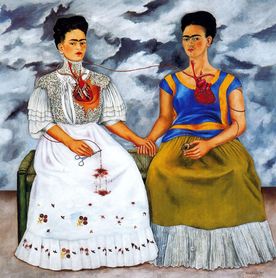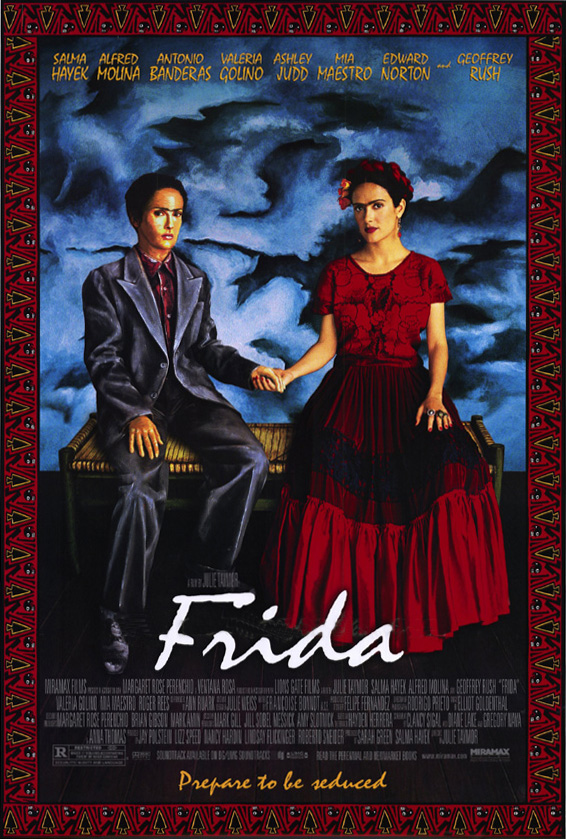 |
| Frida (2002) |
I’ll confess to being a little bit obsessed with Frida Kahlo. A copy of her journals sits on my bookshelf. A postcard of one of her numerous self portraits gazes at me from a bedroom wall. A quote from the movie about her life made an appearance in my wedding ceremony. Hell, I even named my dog “Kahlo.” Personal bias notwithstanding, I love the film Frida, for a myriad of reasons.
In my opinion, biopic is an extremely difficult genre. A person’s life doesn’t fit the narrative arc of a standard movie, so we typically see parts of a person’s life excised, heteronormative relationships emphasized, and vast simplification of an often-famous personality. The best biopics play with the narrative arc, bring in some element of creativity, and allow formal aspects of the film to reflect the subject’s personality. Frida does a good job at this by incorporating surrealism—a reflection of Kahlo’s work—and skipping most of the first eighteen years of her life, in favor of beginning near her artistic awakening. (Two other biopics that also subvert standard moviemaking immediately come to mind: Fur: An Imaginary Portrait of Diane Arbus, about art photographer Diane Arbus, and Beyond the Sea, which looks at the life of singer and entertainer Bobby Darin).
In identity politics terms, Frida tells the story of a disabled bisexual socialist woman of color who became one of Mexico’s most famous painters. That description alone tells you that this isn’t standard fare that the Hollywood machine typically churns out. The film is a decade-in-the-making labor of love for lead actress Salma Hayek, directed by Julie Taymor, and also starring Alfred Molina (as Diego Rivera, fellow painter and husband to Frida), with cameos by Ashely Judd (playing friend, political ally, and photographer Tina Modotti) and Edward Norton (playing Nelson Rockefeller; Norton is also said to be an uncredited writer of the script, and quite a bit of controversy about his role in the making and editing of the film sprung up when he and Hayek ended their romantic relationship).
There is much to admire about Frida as a film, and Kahlo as an artist, for that matter. Although Frida Kahlo was prettied up by the gorgeous Hayek, who did sport Kahlo’s signature unibrow and unbleached/unwaxed moustache, slightly de-emphasized, the difficulties of her life certainly weren’t softened. When Kahlo was six, she contracted polio, which left her with physical difficulties into adulthood. When she was eighteen, she was in a terrible bus accident, leaving her with life-long debilitating pain which required numerous surgeries to resolve (and resolve they never did). The scene below begins with an unconscious Kahlo, immediately following the accident, and takes us through a Day-of-the-Dead-inspired montage of her three weeks in the hospital, until she regained consciousness (warning: the opening image is bloody and disturbing):
The film isn’t just about living with disability, though; it’s about thriving in spite of it, about having a full life in which disability is only a part. Kahlo does not “overcome” her physical problems; she spends a lot of time painting in bed, she has good times and bad, and all of this she channels into her work. As a person who lives with disability, it’s damn near inspiring to see a character–based on a real-life person–who struggles and who achieves great things. And great things Kahlo did achieve. Her body of work includes 143 paintings, 55 of which are self portraits. One of her paintings was the first work by a 20th century Mexican artist to be purchased by the Louvre in Paris, she had a one-woman show in Paris, and has become significantly more famous since her death in 1958. Her work is intensely personal, representing most often pain and the broken self. Not only is this work autobiographical–depicting her own pain and suffering–but it is also overtly feminist. Kahlo painting herself in surrealistic representations of womanhood and pain legitimizes female experiences as worthy of high art. Like so many culturally valued enterprises (filmmaking, for one), men tend to dominate the art world. Kahlo–and the film Frida–challenges those patriarchal norms.
 |
| Le due Frida |
While the film certainly highlights her work as the central element of her life, romantic relationships play a major role as well. Kahlo married the older and more established Mexican muralist, Diego Rivera, when she was 21, and they had a tumultuous relationship, divorcing and remarrying, and having plenty of extra-marital affairs. Their marriage, though, is a kind of model of an artistic pairing; both understanding the other’s devotion to painting and belief in “marriage without fidelity.” Kahlo is known to have had affairs with both men and women, and the film doesn’t gloss over her bisexuality, including a scene with a woman who both Kahlo and Rivera had been sexually involved with. Early indication in the film of her admiration of men and women comes in a somewhat playful party scene, in which Kahlo steps in and wins a drinking contest between Rivera and David Alfaro Siqueiros (played by Antonio Banderas) with the prize of a dance with the lovely Modotti (Judd). The super-sexy tango the two women dance is shown below:
The film, like so many, isn’t without its flaws; one could argue the problem of having a major motion picture about one of Mexico’s most famous artists in which the characters all speak English, for example. Since ten years have passed since the film was made, I can’t be sure whether the same would be true today. Problems aside, this is a visually stunning film, made by a woman, about a woman, and it’s remarkable in nearly every way. If you haven’t seen it, what are you waiting for?

i guess i could agree about the language–same goes for angelina jolie’s in the land of blood and honey–but i LOVE this movie. the acting and the way the story is told–in beautiful artistic montages–is just perfection.
As someone living with a disability causing chronic pain, what I enjoy most about this film is the cinematic treatment of physical trauma. The surrealist scenes alone are wonderful, but Hayek’s subtle treatment of pain–through occasional winces and a convincing limp that does not take over the scene–sold me.
Further, we avoid the “crip myth”–the idea that someone who’s disabled makes up for it or gains from it through art. Frida’s disability in this film is NOT shown as the only source of her work, and in fact, we see how her work suffers at times from her illnesses. This could have easily been a cheesy movie about how disability isn’t really a problem because *look what it creates*, but instead the film lets the complexity of disability–particularly disability in women–be complex and does not issue forth solutions.
The next time I teach this film, I’ll be linking students to this review. Brava!
Candice: I agree with you–love the movie. Just wanted to acknowledge the cultural appropriation by Hollywood re the language issue. Even though Hayek worked to get the movie made, it was still directed by a woman from the U.S. and the script was in English. Not a deal breaker, but still, IMO, important to acknowledge.
amylea: Thank you! You’re right on about Hayek’s performance of chronic pain. These subtle reminders incorporated Kahlo’s disability an *ongoing* issue, and not just something that her character to “conquered” or, as you say, allowed her to be an artist.